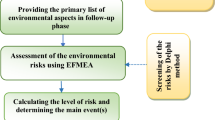Abstract
Identification, assessment, elimination, and control of hazards in every workplace represent the key to success as well as a critical part of any health and safety programme. Due to the complexity of the operations, equipment, and procedures in the rolling industry, this industry always involves some degree of hazard. Hence, it is necessary to apply an effective risk assessment method to manage hazards. In this research, environmental failure mode and effect analysis (E-FMEA) was used to identify possible risks, analyze environmental risks, and determine the highest risk priorities in an aluminium rolling industry. For this purpose, the production process, equipment, and tasks were examined. Stack emissions, as well as factory sewage, were analyzed according to the standard methods. Considering the results of the analysis and according to the expert panel comments, potential harmful factors were identified and classified regarding the possibility of occurrence, capability for discovery, pollution level, and intensity of their effect on the environment. Using the E-FMEA method, 210 aspects and environmental consequences were identified where 27 cases had a low risk, 148 had a moderate risk, and 35 had a high risk. For those classes of risks with a priority number above 118, correction and control operations were accomplished. The results of the repeated risk assessment approved that the protective measures have been satisfactorily effective; the control operations were performed well and the risk priority number (RPN) was mitigated to the low- or moderate-risk levels.



Similar content being viewed by others
References
Angel de la O Herrera, M., Luna, A. S., da Costa, A. C. A., & Blanco Lemes, E. M. (2015). A structural approach to the HAZOP – hazard and operability technique in the biopharmaceutical industry. Journal of Loss Prevention in the Process Industries, 35, 1–11. https://doi.org/10.1016/j.jlp.2015.03.002.
Cheliyan, A. S., & Bhattacharyya, S. K. (2018). Fuzzy fault tree analysis of oil and gas leakage in subsea production systems. Journal of Ocean Engineering and Science, 3(1), 38–48. https://doi.org/10.1016/j.joes.2017.11.005.
Danko, M., Frutiger, J., Jelemenský, Ľ., & Sin, G. (2017). In A. Espuña, M. Graells, & L. Puigjaner (Eds.), Monte Carlo based framework to support HAZOP study (Computer Aided Chemical Engineering) (Vol. 40, pp. 2233–2238).
Ferdous, R., Khan, F., Sadiq, R., Amyotte, P., & Veitch, B. (2011). Fault and event tree analyses for process systems risk analysis: uncertainty handling formulations. Risk Analysis, 31(1), 86–107.
Jabbari, M., Khodaparast, E., Sadri, K., Kavousi, A., & Khalou, S. (2014). A survey on hazardous materials accidents during road transport in Iran. Iran Occupational Health, 11(5), 30–42.
Jiang, W., Xie, C., Zhuang, M., & Tang, Y. (2017). Failure mode and effects analysis based on a novel fuzzy evidential method. Applied Soft Computing, 57, 672–683. https://doi.org/10.1016/j.asoc.2017.04.008.
Jomde, A., Bhojwani, V., Kedia, S., Jangale, N., Kolas, K., Khedkar, P., & Deshmukh, S. (2017). Failure modes effects and criticality analysis of the linear compressor. Materials Today: Proceedings, 4(9), 10184–10188. https://doi.org/10.1016/j.matpr.2017.06.345.
Jozi, S. A., & Hashemi, S. O. (2015). Risk assessment of Khuzestan petrochemical unit of polycarbonate using of PHA and EFMEA combination methods. Quarterly Journal of Environmental Sciences, 13, 103–110.
Jozi, S. A., & Seyfosadat, S. H. (2014). Environmental risk assessment of gotvand-olia dam at operational phase using the integrated method of environmental failure mode and effects analysis (EFMEA) and preliminary hazard analysis. Journal of Environmental Studies, 40(1), 25–27.
Jozi, S. A., Saffarian, S., & Shafiee, M. (2012). Environmental risk assessment of a gas power plant exploitation unit using integrated top-eFMEA method. Polish Journal of Environmental Studies., 21(1), 95–105.
Kabir, S. (2017). An overview of fault tree analysis and its application in model based dependability analysis. Expert Systems with Applications, 77, 114–135. https://doi.org/10.1016/j.eswa.2017.01.058.
Kim, K. O., & Zuo, M. J. (2018). General model for the risk priority number in failure mode and effects analysis. Reliability Engineering & System Safety, 169, 321–329. https://doi.org/10.1016/j.ress.2017.09.010.
Liu, W.-Y., Chen, C.-H., Chen, W.-T., & Shu, C.-M. (2017). A study of caprolactam storage tank accident through root cause analysis with a computational approach. Journal of Loss Prevention in the Process Industries, 50, 80–90. https://doi.org/10.1016/j.jlp.2017.09.004.
Muhlbauer, W. K. (2003). Pipeling risk management manual (3rd ed.). Austin: Gulf Professional Publishing.
Salati, P., & Jozi, S. A. (2012). Environmental risk assessment of low density polyethylene unit using the method of failure mode and effect analysis. Chemical Industry and Chemical Engineering Quarterly, 18(1), 103–113.
Sanjari, A., Saeedi, R., & Khaloo, S. S. (2019). Semi-quantitative health risk assessment of exposure to chemicals in an aluminum rolling mill. International Journal of Occupational Safety and Ergonomics, 1–8. https://doi.org/10.1080/10803548.2019.1617459.
The Aluminum Association. (2007). Rolling aluminum: from the mine through the mill (Third Ed.). Arlington.
Villarini, M., Cesarotti, V., Alfonsi, L., & Introna, V. (2017). Optimization of photovoltaic maintenance plan by means of a FMEA approach based on real data. Energy Conversion and Management, 152, 1–12. https://doi.org/10.1016/j.enconman.2017.08.090.
Wang, P. (2017). Chapter 7 - Failure modes and effects analysis with summary. In Civil Aircraft Electrical Power System Safety Assessment (pp. 187–216). Butterworth-Heinemann.
Wu, J., Pu, G., Ma, Q., Qi, H., & Wang, R. (2017). Quantitative environmental risk assessment for the iron and steel industrial symbiosis network. Journal of cleaner production, 157, 106–117. https://doi.org/10.1016/j.jclepro.2017.04.094.
Yan, F., Xu, K., Cui, Z., & Yao, X. (2017). An improved layer of protection analysis based on a cloud model: methodology and case study. Journal of Loss Prevention in the Process Industries, 48, 41–47. https://doi.org/10.1016/j.jlp.2017.04.006.
Yarahmadi, R., Moridi, P., & Roumiani, Y. (2016). Health, safety and environmental risk management in laboratory fields. Medical Journal of The Islamic Republic of Iran, 30(1), 280–288.
Funding
This work received financial support of from Shahid Beheshti University of Medical Sciences.
Author information
Authors and Affiliations
Corresponding author
Additional information
Publisher’s note
Springer Nature remains neutral with regard to jurisdictional claims in published maps and institutional affiliations.
Rights and permissions
About this article
Cite this article
Khaloo, S.S., Saeedi, R. & Sanjari, A. Environmental risk assessment and corrective measures for the metal rolling industry. Environ Monit Assess 191, 583 (2019). https://doi.org/10.1007/s10661-019-7756-x
Received:
Accepted:
Published:
DOI: https://doi.org/10.1007/s10661-019-7756-x




